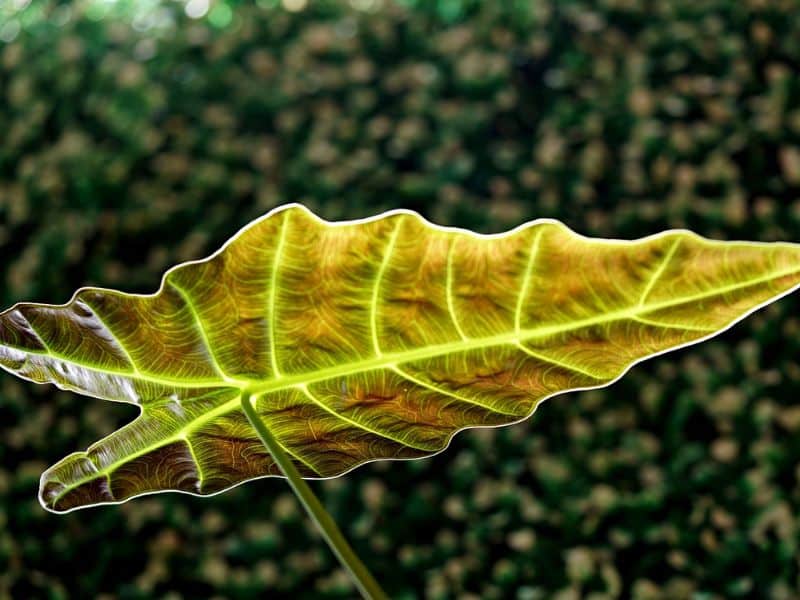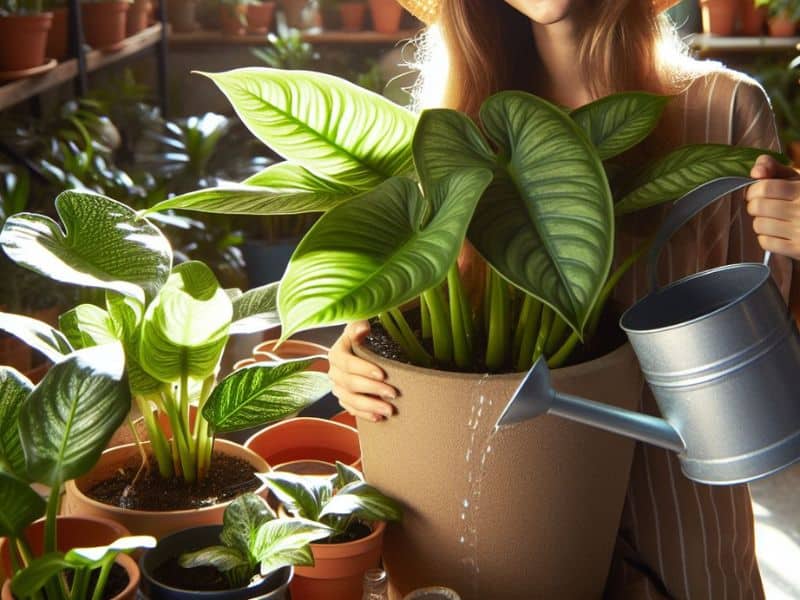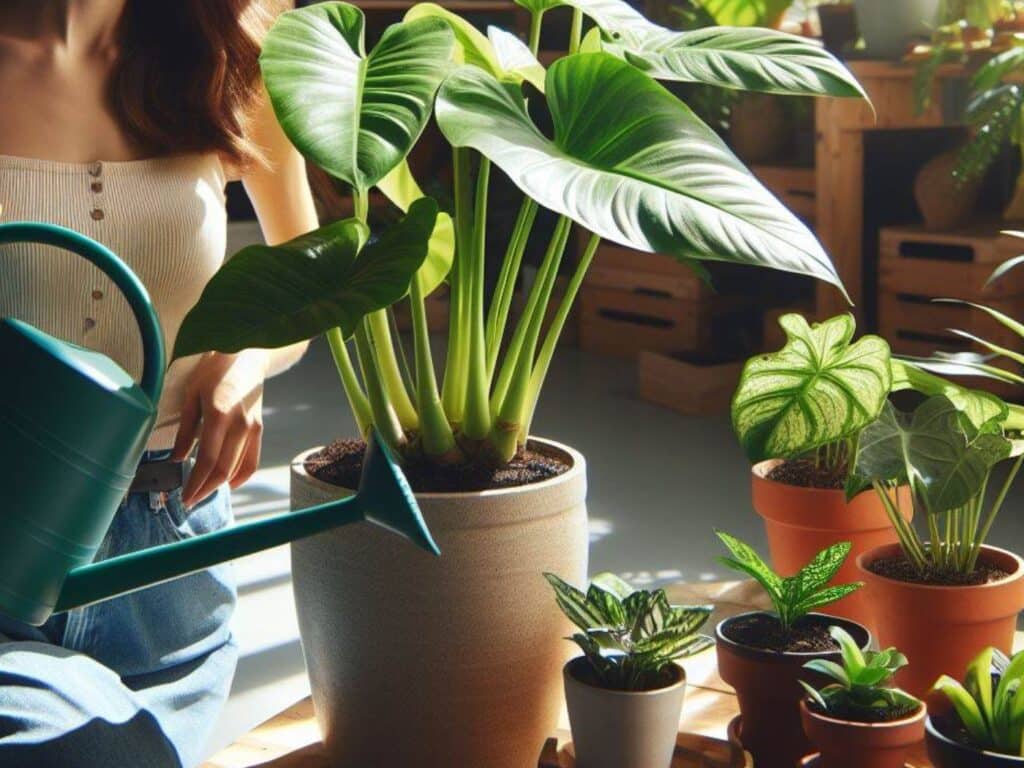Discovering your elephant ear plant’s leaves drooping can be a heart-sinking moment. Often, this is a telltale sign of overwatering, a common pitfall for many enthusiastic gardeners. You’re not alone if you’ve found yourself in this predicament.
Overwatering is a widespread issue that can lead to a host of problems for your beloved plant, including root rot and fungal infections. But don’t despair; recognizing the problem is the first step towards recovery.
Understanding why overwatering impacts your elephant ear plant so negatively and identifying the signs early on are crucial. In this article, we’ll guide you through the causes of overwatering, how to diagnose the issue, and most importantly, how to nurse your plant back to health.
With the right approach, you can reverse the damage and prevent future occurrences, ensuring your elephant ear plant thrives once more. Let’s dive in and explore how you can save your waterlogged green friend.
Signs of an Overwatered Elephant Ear Plant
Catching the signs of overwatering early can save your elephant ear plant from a sad, soggy fate. Here’s what to look out for:
Yellowing Leaves
Yellow leaves are like the plant’s way of waving a white flag. If you notice the leaves turning yellow, it’s screaming for help. This symptom often indicates too much water is trapped in the soil, preventing roots from absorbing essential nutrients and oxygen.
Root Rot
Root rot is the silent killer of many houseplants, and it thrives in overly damp conditions. If your plant’s roots are brown or black and feel mushy instead of firm, root rot has set in. This condition doesn’t just knock on the door; it barges in if overwatering continues.
Limp Stems
Stems that feel more like overcooked spaghetti than sturdy stalks signal trouble. Limp stems often indicate that the plant is drowning. Without proper support from healthy roots, stems lose their vigor.
Mold and Fungus Growth
Lastly, if you spot mold or fungus on the soil surface or the base of the plant, it’s a telltale sign of excessive moisture. These uninvited guests love a damp environment and can lead to a host of problems if not addressed.
Causes of Overwatering

Diving into the causes of overwatering your elephant ear plant can be eye-opening. Understanding these factors is crucial for the plant’s health and vitality.
Excessive Watering Schedule
Believe it or not, loving your plant too much can be its downfall. Overzealous watering is a common mistake. Elephant ear plants require a balance, so soaking them too frequently leads to trouble. If your schedule includes watering more than twice a week, consider dialing it back. Plants need time to breathe between drinks.
Poor Drainage
A plant’s pot is its world; if the drainage isn’t up to par, it’s like living in a swamp for your elephant ear. Ensuring your pot has adequate drainage holes at the bottom is non-negotiable. Pots without proper drainage encourage water to pool at the roots, creating an unwelcome environment for your plant. Sometimes, it’s the simple fixes that make a big difference.
Environmental Conditions
Your home’s environment plays a big role, too. High humidity and cooler temperatures slow down evaporation, meaning soil stays wet longer. If your elephant ear plant resides in a particularly damp or cool spot, water less frequently.
Adjusting your care based on the room’s conditions can prevent overwatering mishaps. It’s all about adapting and observing; your plant will thank you for it.
Summarily, avoiding overwatering involves more than just reducing how often you water. It requires attention to your plant’s drainage needs and an understanding of the environment it’s living in. By keeping these tips in mind, you’ll create a healthier home for your elephant ear plant.
Dealing With Overwatering
After discussing the negative impact of overwatering on elephant ear plants, including symptoms and preventative measures, let’s explore steps you can take to address this issue effectively.
Adjusting Your Watering Habits
The trick to watering elephant ear plants isn’t rocket science, but it does require a bit of attention to their needs. First off, cut back on the frequency of your watering sessions. These plants enjoy moist soil but never soggy.
A good rule of thumb is to let the top inch of soil dry out before giving them another drink. Also, adapt your watering to the plant’s growth cycle—less in winter, more in the active growth months. Remember, the goal is to mimic natural rainfall patterns, not to create a mini flood in your pot.
Improving Soil Drainage
Poor soil drainage is like wearing wet socks; no one likes it, especially not your elephant ear plant. To improve soil drainage, incorporate a mix of peat, perlite, and sand into your existing soil. This blend aids in quick water runoff, preventing water from pooling around the roots.
Additionally, consider adding a layer of gravel at the bottom of the pot to further enhance drainage and prevent the dreaded root rot. A well-draining soil mix keeps the roots happy and healthy, allowing them to breathe and absorb nutrients efficiently.
Repotting Affected Plants
If you’ve caught on to the overwatering issue a bit late, and your plant is already suffering, repotting may well be your best bet. Carefully remove the plant from its current home, gently shake off the excess soil, and inspect the roots. Trim any soft, brown roots as these are toast—literally, they’re no good.
Then, place your plant in a new pot with fresh, well-draining soil, as discussed above. This can feel like plant surgery, but trust me, it’s a relatively painless process for both you and your plant. Repotting gives your elephant ear a fresh start, away from the soggy conditions that dampened its spirits.
Preventative Measures for the Future

Preventing overwatering in elephant ear plants isn’t rocket science, but it does require a bit of know-how and attention to detail. Following the aftermath of overwatering, your goal is to establish a care routine that promotes healthy growth without drowning your green friend in too much love—or water, in this case.
Let’s dive into a few strategies to keep your elephant ear plants thriving.
Understanding Water Needs
Elephant ear plants love moisture, but they don’t want to swim. The key is moderation. During active growth periods in warmer months, your plant craves more water. However, in cooler months, it’s time to cut back. Adjust your watering schedule based on the season and observe your plant’s response.
If the leaves start drooping or turning yellow, you may well be overdoing it. Remember, these plants enjoy consistency, so aim for a steady watering pattern that keeps the soil moist, not soggy.
Choosing the Right Pot and Soil
Opt for pots with drainage holes to let excess water escape, and don’t forget a saucer beneath to catch the runoff. This setup prevents water from pooling at the bottom and encourages a drier environment at the roots. As for soil, a well-draining mix is your plant’s best friend.
Consider a blend of peat, perlite, and sand. This ensures your elephant ear plant gets the moisture it needs without the risk of waterlogging. Choosing the right home for your plant is half the battle in preventing overwatering.
Monitoring Plant Health
Keep an eye on your plant like it’s the star of a reality show. Look for signs of distress, such as yellowing leaves or a wilting appearance, which often signal overwatering.
But also be on the alert for under-watering symptoms, because it’s all about balance. Feel the soil; if it’s consistently wet, you may well want to scale back on watering.
Additionally, investing in a moisture meter can take the guesswork out of watering, letting you know exactly when it’s time for a drink. Regularly monitoring your plant’s health allows you to adjust its care as needed, preventing the dreaded overwatered status and maintaining its lush, vibrant appearance.
Reviving an Overwatered Elephant Ear Plant
Steps to Recovery
Reviving your overwatered elephant ear plant starts with assessing the situation. If the leaves are yellowing or the stem is mushy, it’s time to take action. Firstly, halt watering immediately to allow the soil to start drying out. This may well seem obvious, but enthusiasm for watering needs brakes sometimes.
Next, enhance soil drainage by mixing in perlite or coarse sand, which helps aerate the soil and reduce water retention. This process isn’t rocket science but requires your attention to detail.
Consider repotting the plant if the soil’s condition doesn’t improve. Choose a pot with ample drainage holes and use a well-draining soil mix.
When repotting, gently remove any rotten roots to encourage healthy regrowth. It may well feel a bit like surgery, but your plant will thank you by bouncing back with vigor. Remember, the goal here is to create a comfortable environment for your elephant ear plant to thrive, not just survive.
When to Seek Professional Help
Sometimes, despite your best efforts, your plant’s health may not improve. If the leaves continue to yellow and wilt or if root rot seems extensive, seeking expert advice becomes necessary.
A professional horticulturist can offer specific, targeted advice that goes beyond general care tips. They may well suggest advanced treatments or even a complete overhaul of your plant care strategy.
Don’t feel defeated if you need to reach out for help; consider it a learning opportunity. Caring for plants is an art and a science, requiring a balance of knowledge, intuition, and adaptability.
Plus, connecting with a community of plant enthusiasts can introduce you to new insights and methods for caring for your green friends. Sometimes, it takes a village to save a plant, and that’s perfectly okay.
Up next: Overwatered Christmas Cactus: Revival Tips & Long-Term Care







